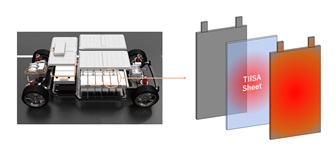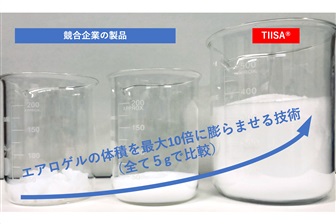Japan-based Thermalytica achieved a breakthrough in the development of a super insulation material that significantly enhances the efficiency and cost-competitiveness of transporting and storing liquid hydrogen.
The patented material, TIISA (thermal insulation inflatable solid air) has high porosity and liquid-like fluidity, providing superior thermal insulation and heat shielding for applications such as liquid hydrogen logistics (both transport and storage), home window insulation, and EV battery thermal runaway mitigation. The technology is set to enter pilot production in Japan by April 2024.
TIISA is a unique silicon dioxide aerogel-like material developed by Rudder Wu, founder and CTO of Thermalytica, who has inked contracts with the Japanese government to validate its ability to reduce the amount of hydrogen boil-off losses from liquefied hydrogen storage.
Established in April 2021 in Japan, Thermalytica has successfully completed its Series-A fundraising round, raising JPY112.5 million (US$850,000). Lead investor was Japan's KSP Inc. The National Institute for Materials Science (NIMS), a national research and development institute under the Ministry of Education, Culture, Sports, Science and Technology (MEXT) is among the stakeholders. Looking ahead, Wu plans to begin the next fundraising around mid-2024, following the company's scheduled completion of its pilot production and commercialization in Japan by the end of fiscal year 2023.
In Japan, the lab scale production capacity of TIISA has reached 500kg per year. The planned pilot production capacity, set to be finished by the end of 2023 in Japan alone, will be over three tonnes. Thermalytica plans to expand commercial production to the US and Taiwan by 2025 to meet the growing demand for TIISA in these markets.
At the time of publication, the accumulated contracts are expected to yield JPY300 million in revenue. The company has garnered significant interest from several Japanese and US automakers, as well as multinational corporations and venture capitalists from around the world.

Rudder Wu, founder and CTO of Thermalytica. Credit: Thermalytica
TIISA
Wu left his full-time permanent research position at the National Institute for Materials Science (NIMS) as he strongly believed that advanced thermal management technology is essential to address major energy and environmental challenges and opportunities facing the world today and anticipated that the demand for TIISA would be enormous.
TIISA has an extremely low thermal conductivity, reaching as low as 1mW/mK at slightly reduced pressure. Additionally, when blended with conventional thermal insulation materials, the composite mixture's thermal conductivity decreases from 30-40 mW/mK to as low as 18mW/mK.
Insulation has also become a critical characteristic of materials to combat climate change and energy crisis. Applications of TIISA range from housing and construction, EV battery thermal runaway mitigation, cryogenic hydrogen transportation to national defense. The use of super insulation can help to keep liquefied hydrogen at an ultra-low temperature to reduce boil-off losses, enhancing air-conditioning efficiency, and accelerating the adoption of green energy.
TIISA is an fluid-like material ideal for use in homes, where it can be physically moved in and out of the gap of double-glazed windows to block heat transfer. It can also be processed into sheets, which can serve as a barrier between lithium battery cells and packs, preventing thermal runaway and minimizing the risk of fire.
TIISA has tested and proven to be able to resist heat up to 1,300 degrees Celsius. Its high porosity makes it even more insulative at a slightly reduced pressure for the material to reach maximum insulation, while conventional aerogels typically require medium to high vacuum to minimize convection and improve insulation.
Wu explained that TIISA is made of smaller silicon dioxide nano particles and the surface is hydrophobic, which increases the porosity and therefore enlarges the total usable volume. Furthermore, the bulk density of TIISA is only one-tenth that of conventional aerogel.

Insulation material TIISA used in EV battery Credit: Thermalytica
Why hydrogen?
Hydrogen transportation and storage is one of the promising use cases of TIISA. According to Thermalytica's estimates, the use of aerogel in hydrogen transportation and storage potentially represents US$45 billion in market size by 2030. Additionally, the market size for aerogel in EV batteries is projected to be US$23 billion by the same year.
Despite its potential as a green energy source, the high costs of liquification and transportation as well as the slower development of hydrogen-based energy compared to solar power, lead to underestimation of the hydrogen economy. But Japan, South Korea, and Taiwan, where land space is inherently scarce and population density is high, face geographic limitations in ramping up renewable energy sources.
As the debate on nuclear power phase-out continues, hydrogen is expected to become a crucial source of green energy, Wu said.
Australia, which runs a green energy surplus generated from solar and wind, is expected to be a major exporter of hydrogen. Solar power converted to hydrogen gas (a process known as "power-to-gas"), which is then liquefied, can be transported in the least volume by bulk liquefied hydrogen carriers.
According to Wu, it takes about two and a half weeks to complete the 9,000km journey of transporting liquefied hydrogen below -253 degrees Celsius from Australia to Japan by sea.
In February 2022, Suiso Frontier, the world's first liquefied hydrogen carrier, marked a historic milestone with the completion of the world's first-ever voyage by a liquefied hydrogen vessel to Japan.
Japan has made significant investments in improving the efficiency of transportation and storage of liquid hydrogen as part of the Japanese government's roadmap to carbon-neutrality. Similarly, the US Department of Energy (DOE) has also committed US$8 billion to establish regional clean hydrogen hubs (H2Hubs) across the country.

Insulation material TIISA Credit: Thermalytica



